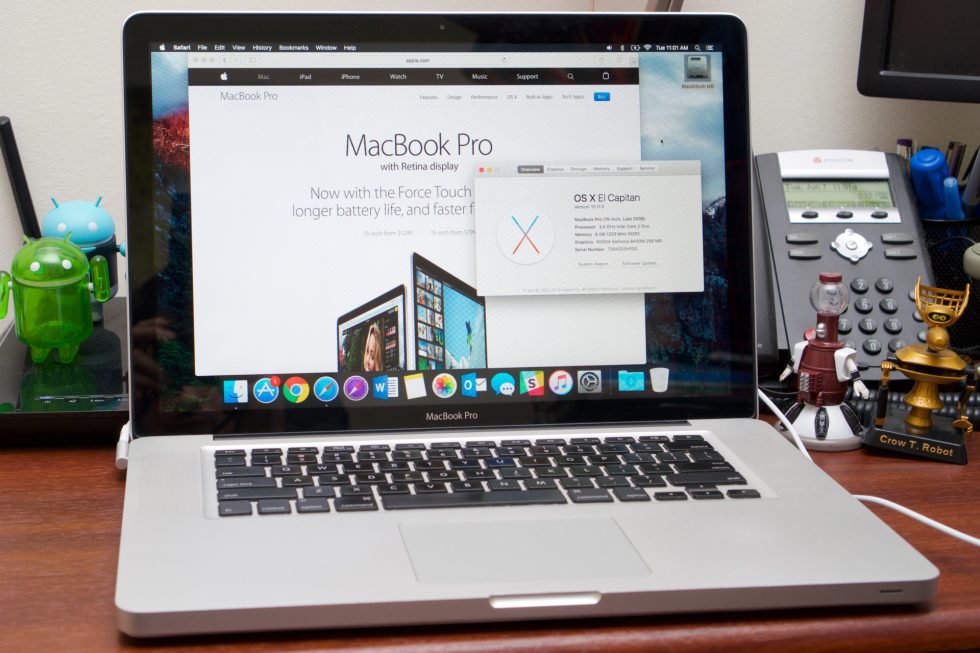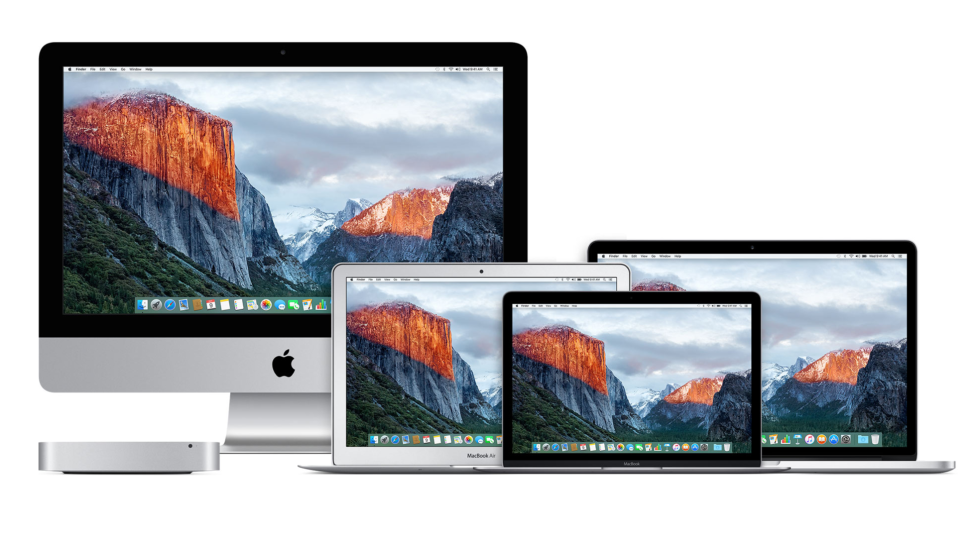
I took a vacation last month. I traveled some. I read a lot. And I refurbished an old late 2008 MacBook Pro, one of the original aluminum unibody models. I completely took it apart, dusted it out, put it back together, and stuck in a memory and SSD upgrade. This is the kind of thing I do to unwind.
There are lots of differences between this thing and a new MacBook of any stripe. The new machines are smaller and they’re thinner and they’re faster and they have better screens, better performance, better batteries. But once you’ve put in a few more modern parts and plunked a fresh install of El Capitan onto the SSD, it feels a whole lot like a modern Mac. Using a Windows laptop from 2008 to run Windows 10 is totally possible, but the screens, trackpads, and general build quality of a laptop from the last year or two will feel way better.
Upgrading and using an old-ish Mac for a bit drives home a point I’ve been trying to articulate for a while—Apple’s Mac lineup simply doesn’t feel ahead of the curve in the ways that it used to. Starting especially with those late 2008 Macs, Apple started some trends (big, multitouch trackpads; chiclet keyboards; aluminum unibody designs) and properly identified others before the rest of the industry could jump on them (SSDs, the death of the optical drive, high-resolution “Retina” displays). Apple led with the MacBook Air and Retina MacBook Pros, and the PC industry largely followed.
I get it. Computers are boring in the age of the smartphone. It’s not a market that’s growing a lot, though Apple typically (but not always) manages to eke out slow growth as the rest of the industry contracts. But the Mac is usually Apple’s second- or third-largest revenue generator after the iPhone and (sometimes, and ever-less-frequently) the iPad. It’s been coasting for the last three or four years while Apple improved the iPhone and iPad and turned its attention to its services and new platforms like the Apple Watch and the Apple TV. Here’s how long it’s been since Apple provided internal and external updates to all of its Macs.
| Hardware | Last refresh | Last redesign |
|---|---|---|
| MacBook | April 2016 | April 2015 |
| MacBook Air | March 2015 | October 2010 |
| 13-inch MacBook Pro | March 2015 | October 2012 |
| 15-inch MacBook Pro | May 2015 | June 2012 |
| Mac Mini | October 2014 | June 2010 |
| 21.5-inch iMac | October 2015 | October 2012 (without Retina display) |
| 27-inch iMac | October 2015 | October 2012 (without Retina display) |
| Mac Pro | December 2013 | December 2013 |
| Thunderbolt Display | July 2011 | July 2011 |
Of those, the MacBook and the iMacs are both fine; they were updated fairly recently and there’s not a whole lot you could change about either machine with current technology. But the “Pro” machines especially are notable in a bad way. Mac designs have always lasted for longer than iPhone and iPad designs and Apple’s release schedule is at least partially determined by Intel’s, AMD’s, and Nvidia’s, but that’s a long time to go without revisiting designs.
Rumors suggest Apple will be paying some much-needed attention to its Mac lineup later this year, possibly at WWDC and possibly in the months after. In the meantime, let’s walk through features Apple could add to the platform and things it could change about individual Macs to keep pace with and get back on top of the industry this company once led.
Biometrics
TouchID, originally released back in 2013 in the iPhone 5S, is now a part of almost every iDevice Apple sells. It’s not a completely tamperproof security mechanism, but it did what it was designed to do. It made basic passcode protection for phones and tablets almost as easy to use as not having any passcode set at all. It’s long past time for something similar to come to the Mac.
Whether that should actually come in the form of TouchID or a similar fingerprint reading technology is up for debate—you typically push your home button to wake your iPhone up anyway, so making the same button responsible for automatically unlocking your phone makes sense. You’ll wake your Mac up by opening the lid or pressing any one of a bunch of keys, so it’s not as natural a fit (it’s not a bad fit, just not as seamless as TouchID on the iPhone).
Windows 10 points to a possible way forward: a few machines come equipped with depth-sensing cameras. Take a picture of yourself (you may need more than one, since the cameras can be confused if the lighting in the room you’re in is significantly different from the one in which you took your original picture), and the camera automatically starts looking for your face when you wake it up. In practice the feature works almost instantaneously, and it accommodates multiple user accounts well.
The camera hardware itself is still a little bulky, though it’s definitely possible to fit it into a laptop the size of a MacBook Air or Pro. And when it comes to questions of fit and finish, Apple has historically been pretty great at making things smaller than people thought they could be; back in the days of the original MacBook Air, Apple actually got Intel to make a purpose-built version of the Core 2 Duo CPU package that was 60 percent smaller than the regular ones.
Other rumors have suggested that Mac owners with iPhones could use their phones’ TouchID to unlock their Macs somehow. Companies like Google have already been toying with the idea—recent Android phones can automatically unlock if they’re within range of a paired Bluetooth accessory, among other things—so it’s not hard to see Apple adding this to its list of Continuity features.
However you implement it, elegant biometrics is the sort of thing that Apple-at-its-best is good at handling. It’s a solved problem for the iPhone, let’s do it for the Mac.
Encryption-by-default
Here's another iOS feature that Apple could probably justify bringing to the Mac in the light of all the publicity it got during its fight with the FBI in the spring. Macs support full-disk encryption in the form of FileVault, which is already pretty easy to turn on and use. It can store your encryption key with Apple via your iCloud account (for convenience) or you can save it somewhere yourself (for security and peace of mind). The OS X setup wizard will already prompt you to turn it on. The next step is turning it on by default.
Performance might be a concern. For any Mac sold within the last half-decade or so, performance won’t be a huge problem, though obviously anything with a spinning hard drive in it will handle it more poorly than something with an SSD. Macs on the older end of the current support list—anything with a Core 2 Duo CPU in it—will also take a larger hit, since those processors don’t have hardware encryption acceleration like most generations of Core i3, i5, and i7 CPUs do.
Windows PCs will encrypt their disks by default when a very specific set of conditions are met; Apple’s control over its hardware ecosystem would make it easier to flip this switch. Apple has spent the last few years building a narrative in which it is the company that most values your security and privacy. Always-on encryption for Macs would fit nicely within this narrative.
SSDs by default in every configuration of every machine

When Apple introduced standard SSDs in the MacBook Air line back in 2010, it felt like a big deal. Solid-state drives were still exotic and expensive, and often commanded a substantial premium over standard spinning disks. And Apple made this change at the same time as it gave the Air a substantial price cut and introduced an even cheaper 11.6-inch model. Most premium laptops today are made in the mold of that 2010-era Air, and the design only really started to feel its age a couple of years ago.
Now, SSDs are more affordable than ever. Many computers—and almost all “premium” computers—include them as the default. And then there’s Apple, which will still sell you a spinning hard drive as the primary disk in $500, $700, $1,099, $1,299, $1,499, and $1,799 computers. A brand-new computer with a high-end CPU and GPU and a bunch of memory doesn’t feel like a brand-new computer with an old hard drive in it. Fusion Drives were invented to marry SSD speed to HDD capacity and price, but it barely feels like Apple is taking advantage of them.
Apple, finish what you started. No more hard drives in thousand-dollar-plus computers.
reader comments
444